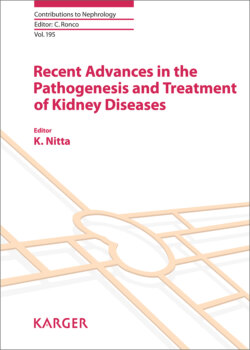Читать книгу Recent Advances in the Pathogenesis and Treatment of Kidney Diseases - Группа авторов - Страница 14
На сайте Литреса книга снята с продажи.
Glomerular Epithelial Cells
ОглавлениеAlbumin particles have been shown to pass through abnormal slit membrane in cases of decreased nephrin expression between the foot processes of glomerular epithelial cells (podocytes). However, in cases of nephrotic syndrome, foot processes are dramatically effaced and the number of slit membranes in the gap is drastically decreased; this provides a useful model to study the intracellular trafficking pathways by which albumin traverses through glomerular epithelial cells.
Tojo et al. [22] reported that in the induced-nephrotic syndrome rat model (using intraperitoneal injection of PAN), a high density of gold-labeled albumin particles were detected in the endosomes of glomerular epithelial cells, and larger FITC-labeled albumin particles were also detected in the bodies of glomerular epithelial cells [22]. Tojo et al. [22] also reported that the Fc receptor (FcRn) functions as a receptor for albumin transportation; in PAN-treated rats, they showed an increase in FcRn-bound albumin in glomerular epithelial cells and a decrease in urinary protein excretion and albumin uptake in podocytes by treatment with anti-FcRn antibody [23]. Recently, in an in vitro study using human urine-derived podocyte-like epithelial cells, FITC-labeled albumin was co-localized with FcRn and endosomes [24], supporting the hypothesis that albumin uses intracellular trafficking pathways to traffic through glomerular epithelial cells. Moreover, Dobrinskikh et al. [24] reported that FITC-labeled albumin particles co-localized with Cav-1 but not with clathrin; in the same study, nystatin (an inhibitor of caveolae-dependent endocytosis) interfered with the internalization of albumin into glomerular epithelial cells, but pitstop2 (an inhibitor of clathrin-mediated endocytosis) did not [24]. The cholesterol-lowering agents, statins, also interfered with the endocytosis of albumin into glomerular epithelial cells during in vitro and in vivo assays [25]. Additionally, caveolae are enriched in cholesterol and sphingolipids, and statins have been reported to interfere with caveolae-dependent BK virus internalization into renal proximal tubular epithelial cells [26], further supporting the hypothesis of the endocytosis of albumin through caveolae. Taken together, these results suggest that FcRn-bound albumin particles enter glomerular epithelial cells through caveolae and are transported to early endosomes. In another study, it was demonstrated that, after the endocytosis of albumin through caveolae, albumin particles were transported to early endosomes that move along actin; further, several albumin particles were degraded in lysosomes [27]. Albumin exposure also induced cell apoptosis through combined activation of caspase 3/7 and nuclear factor kappa B and release of interleukin-1β, tumor necrosis factor, and interleukin-6 [28]. In a recent report, Schießl et al. [29] used an intravital multiphoton microscope to show transcellular transport of albumin – through caveolae – across the glomerular epithelial cells, and noted that this transcytosis increased upon stimulation with angiotensin II [30]. These data imply that there may be a transcellular pathway for albumin transport across glomerular epithelial cells.
